Nick Metcalfe's Blog, page 7
February 1, 2017
Blacker’s Letters – January 1917
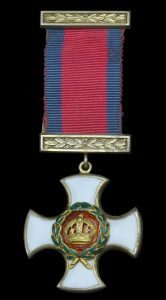
Distinguished Service Order
Lieutenant Colonel Blacker was awarded the Distinguished Service Order in the New Year Honours and when he returned from leave at the beginning of January 1917 he assumed temporary command of 108th Brigade. Nonetheless, he still found time to visit and comment about the activities of the Battalion. His letters home written in January have now been published and they can be read on the project’s website.
January 14, 2017
For Exemplary Bravery – The Queen’s Gallantry Medal
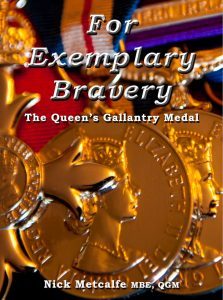
Most new information that I have received since the publication of For Exemplary Bravery has now been consolidated into a single addendum, which can be read or downloaded from the book’s page (link titled ‘Read the Update…’). It’s in the same format as the book and contains the new awards up to December 2016. I will revise it to add details of new awards as they occur (the next civilian gallantry awards list should be published on 24 January 2017) and any additional information that I receive about previous recipients. Many thanks, again, to those who have contributed to the project.
January 5, 2017
John Adams – Letters From The Front
Letters From The Front tells the story of one of the men of the 9th Royal Irish Fusiliers—John Adams—who twice earned the Military Medal and was twice wounded. In a series of podcasts, his letters are read 100 years after they were written. January’s podcast also features a piece by me about how I came to write Blacker’s Boys. The whole thing is only 10 minutes long—have a listen!
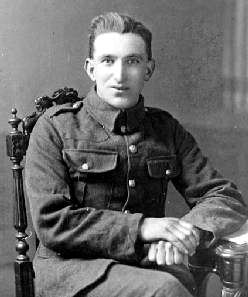
Sergeant John Adams MM
December 28, 2016
Gallantry During The Blitz – 29 December 1940
Seventy-six years ago, on the evening of 29 December 1940, a German bombing raid caused what become known as the ‘Second Great Fire of London’. Taken in the aftermath of this raid, the iconic photograph of St Paul’s Cathedral in the blitz came to symbolise London’s defiance. The attack on 29 December targeted the City of London where the high explosive and incendiary bombs started a firestorm that swept all before it. The area destroyed was more than that devastated by the Great Fire of 1666. It cost the lives of over 160 civilians and 14 firemen.

St Paul’s Cathedral, 29 December 1940
The attack and the response to it by the emergency services and the people of London is explored in detail by Margaret Gaskin in her excellent book Blitz: The Story of 29th December 1940—a most thorough description of the night’s events told largely through the memories of those who were there.[1] Although Gaskin describes in some detail the bravery of those responding to the fires, she only alludes to the gallantry awards that were made in consequence of those acts. In all, the fierce bombing raid and firestorm of 29 December resulted in 44 gallantry awards—one MBE, eight George Medals, 22 British Empire Medals and 13 Commendations for Brave Conduct—more than for any other single event during the blitz.[2]
Member of the Civil Division of the Most Excellent Order of the British Empire [3]
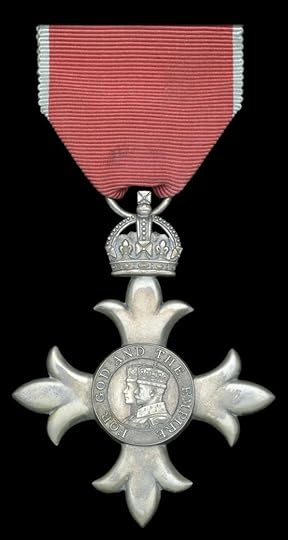
Badge of a Member of the Order of the British Empire
Henry George Davies, Superintendent, London Fire Brigade.
Armoury House, City Road, Finsbury (now Islington).
London Gazette 25 July 1941. Issue 35226.
When a serious fire, started by enemy action, threatened to involve an important building, Superintendent Davies took charge of the area. Very little water was available, apart from that contained in a battery of dams but by judicial use of this he succeeded in retarding the spread of the fires. He organised a convoy of mobile dam lorries and by energetic perseverance, he managed to prevent the premises becoming involved. Although suffering severely from injury to his eyes, Davies continued to take charge until late in the following morning, at which time his eyes had become so swollen that it was difficult for him to see. It was due to his leadership, initiative and courage that the buildings were saved and the fire held.
George Medal

The George Medal
Arthur James Ball, Sub-Inspector, City of London Police.
(See British Empire Medal for Luckman and Salmon below.)
City of London.
London Gazette 2 May 1941. Issue 35149.
During a heavy raid Sub-Inspector Ball, Police Sergeant Luckman and Police Constable Salmon displayed great courage and devotion to duty following the fires caused by the dropping of H.E. and incendiary bombs. The three men entered burning premises, at great risk to their lives, to rescue the occupants. They were responsible for the evacuation of people from shelters which were endangered by fire. Although the officers were badly shaken by blast and injured, they continued to render assistance throughout the night wherever their services were required.
John Cornford, Temporary Acting Sub-Officer, London Fire Brigade.
Arthur Ronald Thorn, Station Officer, London Fire Brigade.
Southwark Street, Southwark.
London Gazette 2 May 1941. Issue 35149.
High warehouses abutting on the pavement on both sides of a street were well alight and the fire was sweeping across the sixty foot wide roadway. A man staggered out of one of the burning buildings and collapsed. Station Officer Thorn and Sub-Officer Cornford immediately ran through heat and flame, with debris falling all about them, and brought the man clear of the area. Thorn and Cornford acted promptly and at great risk to their lives to effect this gallant rescue.[4]
Charles William Hill, Sub-Officer, Hendon Fire Brigade.
Edward William Robert Morgan BEM, Station Officer, London Fire Brigade.[5]
51 City Road, Finsbury (now Islington).
London Gazette 1 August 1941. Issue 35233.
During a heavy air raid on London two persons were trapped in the basement of a building that was alight from ground to top floor. Station Officer Morgan and Sub-Officer Hill entered the building by the ground floor passage but were unable to advance owing to the terrific heat. The Officers then broke the pavement light and by this means entered the basement. Although the heat and smoke were intense Morgan and Hill brought the two trapped persons to a position in the front part of the basement from which they were hauled up to the street. Sub-Officer Hill was then helped out and finally Station Officer Morgan, who was considerably affected by-the smoke and in a very exhausted condition, was assisted up to the ground level by means of a line. During the time that the rescue was being effected the rear part of the building collapsed. Both Morgan and Hill showed utter disregard of danger and displayed conspicuous courage and fortitude.
Charles George Toni Mann, Police Constable, L Division, Metropolitan Police.
24 De Crespigny Park, Camberwell.
London Gazette 25 April 1941. Issue 35143.
A man was trapped, thirty feet from the ground, on the first floor of a house which had been partially demolished by a bomb. A ladder was placed against the wall but this only reached about eighteen feet, leaving a gap between the top of the ladder and the window. It was feared that the house would collapse at any moment, but P.C. Mann mounted the ladder and, on reaching the top rung, flattened himself against the wall. He was still unable to reach the window ledge but managed to stretch upwards a little higher by placing his right foot on the damaged framework of the ground floor window. The man was then encouraged to climb out backwards and gradually lower himself. The constable took most of the man’s weight on his right hand and lowered him on to his shoulders. P.C. Mann then climbed down the ladder to safety. The least mistake by the Constable would have resulted in both men being severely injured. Mann displayed cool courage and resource in the face of danger and difficulty.
Edward Heslop Smith, Chief ARP Warden, Poplar.
Our Lady & Saint Catherine of Siena Catholic Church, Bow Road, Poplar.
London Gazette 25 April 1941. Issue 35143.
A H.E. bomb wrecked a building and the main gas line was broken and ablaze, lighting up the sky and endangering the adjoining premises. It was not possible to turn off the gas from outside. Chief Warden Smith immediately climbed into the wreckage, removing fallen debris as he went. He ran the grave risk of being crushed beneath the parts of the roof and ceiling still crashing down, or of being trapped by the fire. Without regard for his personal safety he set to work to stem the flames and get the gas under control. After half an hour he succeeded. Smith’s courage and self-sacrifice prevented a very serious spreading of the fire rand saved the district from possible disaster.
Robert Hamilton Tinto, 2327174 Signalman, Royal Corps of Signals.
Keyworth Street, Southwark.
London Gazette 27 May 1941. Issue 35173.
For conspicuous gallantry in carrying out hazardous work in a very brave manner. Signalman Tinto entered a wrecked shelter through a very small aperture and with bare hands dug away earth thereby making possible the rescue of four people. The rescue party was endeavouring to move a large slab of concrete immediately above him; he remained in this position for four hours administering morphia and re-assuring the trapped people.[6]
British Empire Medal (Civil Division) [7]

The British Empire Medal
Robert Wood Berwick, Auxiliary Fireman, East Ham Auxiliary Fire Service.
Settles Street, Commercial Road, Stepney.
London Gazette 6 June 1941. Issue 35180.
During an air raid, whilst engaged with a branch-pipe on the roof of a church, Berwick heard a cry for help. A man had fallen from the roof into a space approximately two feet wide and twenty feet deep, between the church and an adjoining building. Although the church was burning fiercely, Berwick procured a length of rope and, with help, climbed down to the casualty, secured him to the rope, and hauled him up. He then carried him along the roof to a ladder, down which the injured man was lowered. Berwick performed this gallant action at considerable risk to himself.
Albert Ernest Bills, Station Officer, London Fire Brigade.
City of London.
London Gazette 25 July 1941. Issue 35226.
Station Officer Bills was in charge of a fire in the City area during an air raid. He maintained communications and organised water supplies in spite of great difficulties. The fires in his area became so serious that, with half his men practically smoke-blind, he decided upon the very difficult task of evacuating them and the appliances to safety. Then he thoroughly searched all surrounding streets to ensure that everyone had left the area, being himself the last one to leave. Station Officer Bills set a splendid example to the men by his coolness, energy and courage.
Charles Robert Brooks, Auxiliary Fireman, East Ham, Auxiliary Fire Service.
Frederick Walter Chantrell, Leading Auxiliary Fireman, East Ham, Auxiliary Fire Service.[8]
Cripplegate, City of London.
London Gazette 6 June 1941. Issue 35180.
After fighting fires for several hours Chantrell received an order to get his crew away and leave the equipment, as all means of escape seemed to be barred by flames. Brooks volunteered to attempt to save the pumps and, with Chantrell in charge, the crew mounted in their position. Using mackintoshes and hose ramps to protect themselves from the heat and falling embers and despite fallen masonry and piles of debris which at some points barred the way, Brooks eventually succeeded in driving the pump and crew to safety.
George Burgess, Leader, ARP Rescue Party, Kingston-upon-Thames.
Patrick Dever, Member, ARP Rescue Party, Kingston-upon-Thames.
Alexander Keith Hay, Stretcher Party Officer, Kingston-upon-Thames.
Frederick John Reeves, ARP Warden, Kingston-upon-Thames.
156-164 Elm Road, Kingston-upon-Thames.
London Gazette 2 May 1941. Issue 35149.
A H.E. bomb demolished houses and trapped a man under debris which was smouldering. Tunnelling work was carried out by Burgess, Reeves and Hay. They worked in the heat and the smoke from the smouldering fire for four hours until the head and body of the casualty were uncovered, but he was still held down by wreckage. It was possible for only one man to work in the tunnel at a time and Dever went in. After half-an-hour of very strenuous work with an axe he was able to release the casualty, who was carefully withdrawn from his perilous position and removed to hospital. It was due entirely to the determination and bravery of the four men that this rescue was accomplished. A partly demolished wall immediately adjoining the site collapsed on to the debris under which they had been working, shortly after the rescue had been completed.
Harry George Harvey, Acting Station Officer, London Fire Service.
Moorgate, City of London.
London Gazette 22 August 1941. Issue 35252.
Acting Station Officer Harvey was in charge of a number of appliances at fires caused by enemy action. The fierceness of these fires caused Harvey to become almost blind but, in spite of very severe pain, he continued to go from one fire to another directing operations and encouraging the men in his charge. He displayed great powers of endurance and devotion to duty.
Joan Winifred Hobson, Auxiliary, London Women’s Auxiliary Fire Service.
20 Deveraux Court, Westminster.
London Gazette 1 August 1941. Issue 35233.
During an air raid, a fire was reported but no appliances were available. Auxiliary Hobson, on her own initiative, took lengths of hose, a short ladder and equipment, and, commandeering a car, attended the fire with two auxiliary firemen. She fought the flames from the roof opposite for three and a half hours and succeeded in checking the outbreak, thereby saving the lower rooms and the surrounding buildings. During the time that Auxiliary Hobson was at work, bombs fell nearby. She showed remarkable initiative and courage throughout the incident.
Reginald William La Fosse, Watchroom Attendant, London Fire Brigade.
City of London.
London Gazette 25 July 1941. Issue 35226.
During an air raid it was necessary to supply appliances working at fires with additional petrol. La Fosse, acting entirely on his own initiative, obtained a staff car, loaded it with cans of petrol and drove round the district distributing it where required. He carried on with this arduous work, which was not part of his normal duty, regardless of danger from falling debris, until the next morning. But for the initiative and courage shown by La Fosse some of the appliances would have ceased to function, with the possibility of the fires getting out of control.
Robert Luckman, Police Sergeant, City of London Police.
Charles Salmon MM, City of London Police.[9]
(See George Medal for Ball above.)
City of London.
London Gazette 2 May 1941. Issue 35149.
During a heavy raid Sub-Inspector Ball, Police Sergeant Luckman and Police Constable Salmon displayed great courage and devotion to duty following the fires caused by the dropping of H.E. and incendiary bombs. The three men entered burning premises, at great risk to their lives, to rescue the occupants. They were responsible for the evacuation of people from shelters which were endangered by fire. Although the officers were badly shaken by blast and injured, they continued to render assistance throughout the night wherever their services were required.
Stanley Tyrrell Newell, Leader, ARP Rescue Party, Camberwell.
Ernest Daniel Rider, Member, ARP Rescue Party, Camberwell.
82 Grove Lane, Camberwell.
London Gazette 13 June 1941. Issue 35188.
A H.E. bomb partly demolished two houses. Newell sawed through two floors to the top of the building and lowered two women to safety by means of a rope. Rider, by scratching away debris and wreckage in the other house was able, after three hours, to rescue two people who had been trapped. Both men were in grave danger from an unexploded time bomb nearby and, whilst the rescues were being effected, more bombs were dropped which caused further collapse of the buildings. Newell and Rider showed great courage and devotion to duty.
Alicia Perris, Section Officer, London Women’s Auxiliary Fire Service.
(See Commendation for Nightingale below.)
Baltic Street School, Clarkenwell, Finsbury (now Islington).
London Gazette 25 July 1941. Issue 35226.
Section Officer Perris was on duty in the watchroom of an A.F.S. station which was set on fire during an air raid. She was ordered to evacuate the building but notwithstanding the danger of the situation, made certain, before leaving, that as many important records as possible were taken to safety. She took over watchroom duties at another Station until it again became necessary to evacuate. Section Officer Perris maintained her courage and composure and gave most able assistance in establishing control, and taking over watchroom duties. Throughout the raid Section Officer Perris showed great devotion to duty, disregard of danger, and fine qualities, of leadership.
Edwin James Povah, Deputy Leader, ARP Rescue Party, Willesden.
764 Harrow Road, Willesden.
London Gazette 12 September 1941. Issue 35271.
A high explosive bomb damaged a house and five persons were trapped inside. The only means of obtaining access was by tunnelling under a wall which was in an extremely unsafe condition. Mr. Povah personally carried out most of this tunnelling work which took about three hours. He displayed great determination and courage and by his efforts the five persons were rescued.
David Reading, District Officer, London Fire Brigade.
City of London.
London Gazette 25 July 1941. Issue 35226.
During an air raid District Officer Reading took charge of an area of intense fire comprising a number of City streets. In the face of great danger he made his way from street to street, safeguarding the lives of his crews and withdrawing appliances when excessive danger made this step imperative. When the fires were at their height it was reported to him that two employees of a firm were still at their posts. With great difficulty Mr. Reading succeeded in reaching them and helped them to make their way out when most exits were cut off by fire and the whole building smoke logged. Mr. Reading suffered acutely owing to the painful condition of his eyes through the intense heat and smoke but in spite of this his direction enabled the crews to save a large building from total destruction.
Charles Henry Thatcher, Temporary Leading Fireman, Carshalton Auxiliary Fire Service.[10]
Barbican, City of London.
London Gazette 6 June 1941. Issue 35180.
After fighting fires for several hours in the City of London it became necessary for Thatcher to transfer the operations of his crew as it appeared that all means of escape would soon be cut off. Whilst part of his crew held back the fire at one point, the remainder made up their equipment and prepared to leave. Driving through the flames they managed to make their escape into another street, only to find that it was a sheet of flame at both ends and seemingly impossible to traverse. As it was impossible to save the vehicle, Thatcher organised a salvage party and leading his men through an underground tunnel to safety was successful in saving much of the equipment.
Stanley Thompson, ARP Warden, City of London.
St. Dunstan-in-the-West, Fleet Street, City of London.
London Gazette 5 September 1941. Issue 35264.
Warden Thompson, who is Verger of St. Dunstan-in-the-West, has shown courage and devotion to duty during air raids and by his initiative has prevented serious fires. When tackling incendiary bombs on the roof of the vestry of his Church he was blown to the ground by an explosion but although badly shaken he continued to fight the fires. On another night his prompt action in dealing with an incendiary bomb which penetrated the roof of the Church undoubtedly saved the building from destruction.
Cyril Gordon Tobias, District Officer, London Fire Service.
City of London.
London Gazette 22 August 1941. Issue 35252.
When high explosive and incendiary bombs caused several fires in his area, District Officer Tobias took charge of the operations. The water supply failed but with initiative and skill he organised a relaying service which prevented the fires from spreading. It was necessary for him frequently to visit the water relaying units and the journeys, which had to be made on foot, were extremely dangerous owing to falling debris. Tobias remained continuously at work for nineteen hours and he showed great coolness, efficiency and exceptional qualities of leadership.
Tom Nicholas Wilcock, Station Officer, London Fire Brigade.
(See Commendations for Blunden, Calvert, Little, and Walker below.)
Peckham Road, Peckham.
London Gazette 21 March 1941. Issue 35111.
Station Officer Wilcock was in charge of a Fire Pump when a bomb exploded nearby, disabling the appliance, severely wounding one member of the crew and injuring two others. Several trams and a char-a-banc were wrecked, and two gas mains, one on each side of the road, were fractured and set on fire. Assisted by his men, he forced his way into a burning tramcar and extricated the injured conductor and passengers. After his wounds had been dressed he returned to the station, and, obtaining a spare appliance, had it manned by some of his crew, with himself in charge. Wilcock, although suffering great pain from cuts and shock caused by glass splinters and blast, showed initiative and courage.
Commendation for Brave Conduct[11]

Commendation for Brave Conduct
James Anderson, Control Room Messenger, Public Cleansing Department, City of London.
Aldermanbury, City of London.
London Gazette 25 April 1941. Issue 35143.
Devotion to duty after injury at Aldermanbury in the City of London on 29 December 1940.
Ivy Louise Ashwell, Auxiliary, London Women’s Auxiliary Fire Service.
Winifred Brock, Auxiliary, London Women’s Auxiliary Fire Service.
Ivy Angel Trood, Auxiliary, London Women’s Auxiliary Fire Service.
Virginia Road School, Bethnal Green.
London Gazette 1 August 1941. Issue 35233.
For initiative and devotion to duty at Virginia Road School Fire Service Station at Shoreditch on 29 December 1940.
Harry George Percy Blunden, Fireman, London Fire Brigade.
James Calvert, Fireman, London Fire Brigade.
Reginald Bertram Little, Fireman, London Fire Brigade.
Frederick Charles Walker, Temporary Acting Sub-Officer, London Fire Brigade.
(See British Empire Medal for Wilcock above.)
Peckham Road, Peckham.
London Gazette 21 March 1941. Issue 35111.
For fighting fire and rescuing people trapped in burning tramcar in Peckham Road, Peckham on 29 December 1940.
Isaac Bogard MM, ARP Stretcher Party Leader, City of London.[12]
City of London.
London Gazette 25 April 1941. Issue 35143.
For devotion to duty fire fighting during the night of in the City of London despite being injured on 29 December 1940.
Charles William McCarthy, Member, Reuters and Press Association Fire Fighting Squad, London.
St Bride’s Church, Fleet Street, City of London
London Gazette 23 May 1941. Issue 35169.
For fire fighting at St Bride’s Church, City of London, on 29 December 1940.
Ellen Sophia Nightingale, Auxiliary, London Women’s Auxiliary Fire Service.
(See British Empire Medal for Perris above.)
Baltic Street School, Clarkenwell, Finsbury (now Islington).
London Gazette 25 July 1941. Issue 35226.
For devotion to duty at the Baltic Street School watchroom, Clarkenwell on 29 December 1940.
John Herbert Sutton, Auxiliary Fireman Driver, Penge Auxiliary Fire Service.
Golden Lane, City of London.
London Gazette 30 May 1941. Issue 35174.
For devotion to duty at Golden Lane, City of London on 29 December 1940.
Philip Henry Williams, Auxiliary Messenger, London Auxiliary Fire Service.
City of London.
London Gazette 1 August 1941. Issue 35233.
For carrying messages and fire fighting in the City of London on 29 December 1940.
Acknowledgements:
Imperial War Museum: Photograph of St Paul’s Cathedral
Dix Noonan Webb: Photographs of the medals.
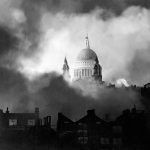

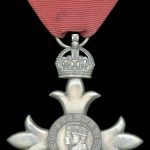

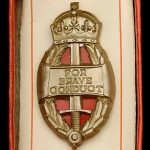
1. (Back) Gaskin, M. (29 September 2005). Blitz: The Story of 29th December 1940. London: Faber & Faber.
2. (Back) These awards were published in a series of editions of the London Gazette; most of the citations did not identify the date of the event for which awards were made. Original recommendations may be found in: The National Archives (TNA). Public Record Office (PRO). Home Office: Inter-departmental Committee on Civil Defence Gallantry Awards: Minutes and Recommendations. HO 250. The relevant London Gazettes are:
London Gazette 21 March 1941. Issue 35111.
London Gazette 25 April 1941. Issue 35143.
London Gazette 2 May 1941. Issue 35149.
London Gazette 23 May 1941. Issue 35169.
London Gazette 27 May 1941. Issue 35173.
London Gazette 30 May 1941. Issue 35174.
London Gazette 6 June 1941. Issue 35180.
London Gazette 13 June 1941. Issue 35188.
London Gazette 25 July 1941. Issue 35226.
London Gazette 1 August 1941. Issue 35233.
London Gazette 22 August 1941. Issue 35252.
London Gazette 5 September 1941. Issue 35264.
London Gazette 12 September 1941. Issue 35271.
3. (Back) The Order of the British Empire was used to reward acts of gallantry not at the level required for a George Medal. The award (Commander, Officer, Member or Medal) reflected the rank, grade or level of responsibility of the recipient. From 1958 crossed silver oak leaves were worn on the ribbon to indicate an award for gallantry.
4. (Back) The rescued man later died in King’s College Hospital of severe burns.
5. (Back) Morgan was three times decorated for gallantry. Later E W R Morgan GM, KPM, BEM.
British Empire Medal (Civil Division), Station Officer, London Fire Brigade. Great Portland Street, 16 September 1940. A large six-floor warehouse received direct hits from bombs. Whilst fire-fighting’ was in progress, crews were subjected to further bombing and the Officer in charge was killed. Others of the detachment were severely injured, water mains fractured and gas mains set alight. Station Officer Morgan temporarily assumed command. The severely injured were removed to hospital, the water supply was augmented and the fire brought under control. This was in large measure due to his courage and leadership. London Gazette 28 March 1941. Issue 35117, page 1781.
King’s Police and Fire Service Medal for Gallantry, Temporary District Officer, London Fire Brigade. For the rescue of a family from a burning flat in March 1941. London Gazette 1 January 1942. Issue 35399, page 55.
6. (Back) TNA. PRO. (1941). Recommendation for Award for Tinto, Robert Hamilton. WO 373/66/1006.
7. (Back) The Order of the British Empire was used to reward acts of gallantry not at the level required for a George Medal. The award (Commander, Officer, Member or Medal) reflected the rank, grade or level of responsibility of the recipient. From 1958 crossed silver oak leaves were worn on the ribbon to indicate an award for gallantry.
8. (Back) Unsuccessful recommendations were made in this case for Auxiliary Firemen Herbert Gillham, Bertram Hayden Lovell, and William Thomas Snow.
9. (Back) Military Medal, L/37984 Signaller, Royal Field Artillery. London Gazette 17 June 1919. Issue 31405, page 7653.
10. (Back) Unsuccessful recommendations were made in this case for Auxiliary Firemen Edwin George William Bell, Wilfred George, Harry Freeman James Hayes, John Thomas Montague, and Charles Francis Webster.
11. (Back) This award became known as the King’s Commendation for Brave Conduct in 1945.
12. (Back) Military Medal, 263049 Private, 10th (Service) Battalion, The South Wales Borderers. London Gazette 23 February. Issue 30540, page 2415. Decorated for gallantry in both wars, Bogard had also been a well-known East End hoodlum before the First World War.
December 8, 2016
Christmas Cards of the Great War
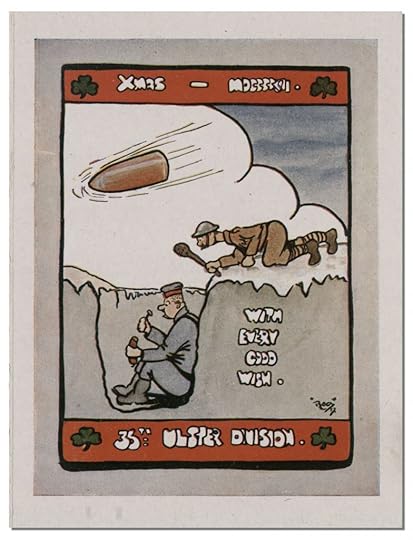
The interior of the 36th (Ulster) Division card for 1917
As we approach Christmas, I thought I would share a selection of the First World War Christmas cards that have been sent to me, for one reason or another, over the years.
These cards are of two types—those commissioned with an appropriate theme for a unit or formation, and those produced locally for soldiers to buy. The locally produced cards were made to a very high standard and were not confined to Christmas greetings. Made year-round as general souvenirs and to commemorate specific events, many were embroidered in rich colours with patriotic designs. Early in the war the embroidery, on silk organza or similar fine material, was done by women as piecework for companies who then mounted the embroidery on cards with printed messages. Later, the popularity of the cards resulted in machine embroidered cards assembled in factories. It is commonly estimated that as many as 10 million such cards were produced during the war, mainly in France.
The card below was sent home at Christmas 1915 by Private John Atwell of ‘B’ Company, 9th Royal Irish Fusiliers. Atwell was wounded in 1916 and 1917 and captured in March 1918. His brother Edward lost his right leg because of wounds suffered on 1 July 1916.

The card shows the Union Flag and a green flag bearing the crowned, winged-maiden, Irish harp—a flag associated with Ireland in various forms since the 17th Century. The Red Hand of Ulster is surrounded by a wreath of shamrock.
This card was sent home, also in 1915, by Sergeant Henry Fox, who became the Regimental Quartermaster Sergeant of 9th Royal Irish Fusiliers in February 1917, incredibly aged only 20 years old. He was wounded in 1917.
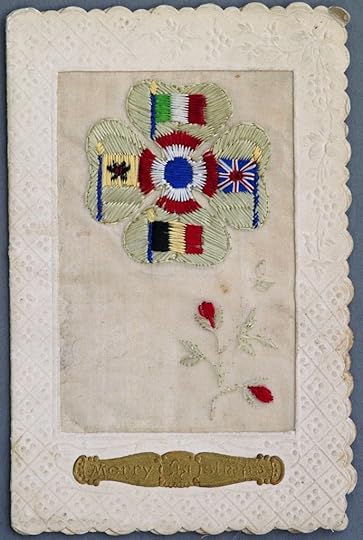
The card shows the flags and colours of five of the Allies on a four-leaf clover; clockwise from the top: Italy, the United Kingdom, Belgium,and Serbia, with the colours of France making up the central roundel. The flowers at the bottom are probably poppies.
16th Royal Irish Rifles, the Pioneer Battalion of 36th (Ulster) Division, commissioned this card for Christmas 1915, the Battalion’s first Christmas in France. This card was sent to ‘Mother, Sister and Brother‘ by Private Robert Sergeant.
![The front of the card shows the Battalion crest comprising a scroll with the Battalion name, a Tudor crown over the winged-maiden Irish harp, the Regimental motto Quis Separabit [Who shall separate (us)?], the bugle associated with rifle regiments and light infantry, and the descriptor ‘Pioneers’, the role of the Battalion. The interior had space for a photograph (in this case No. 2 Company). The card is tied with a black and green ribbon, the colours traditionally associated with rifle regiments.](https://i.gr-assets.com/images/S/compressed.photo.goodreads.com/hostedimages/1481309173i/21410762._SX540_.jpg)
The front of the card shows the Battalion crest comprising a scroll with the Battalion name, a Tudor crown over the winged-maiden Irish harp, the Regimental motto Quis Separabit [Who shall separate (us)?], the bugle associated with rifle regiments and light infantry, and the descriptor ‘Pioneers’, the role of the Battalion. The interior had space for a photograph (in this case No. 2 Company). The card is tied with a black and green ribbon, the colours traditionally associated with rifle regiments.
Most of those of whom I have written were killed or wounded in 1916 and I don’t have a 1916 card in my collection. The next card was sent home to his wife at Christmas 1917 by Captain Jim Partridge. He had joined 9th Royal Irish Fusiliers in December 1916 and earned the Military Cross during the Battle of Cambrai. He was killed in action in March 1918. Note the amendment to the front of the card.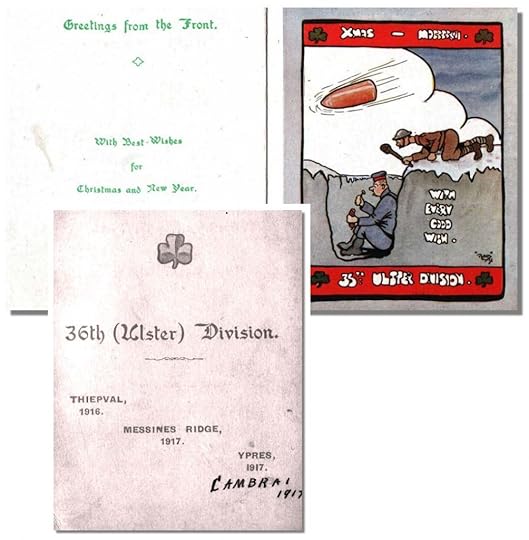
The 36th (Ulster) Division Christmas card for 1917 appears to have been printed prior to the Cambrai attack in November 1917—Captain Partridge made the manuscript amendment to include that attack. I particularly like the caricature of sausage-eating Fritz.
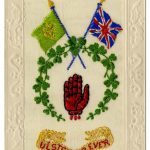
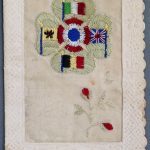
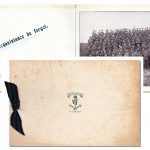
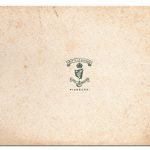
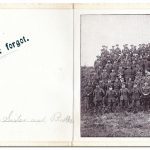


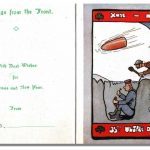
December 1, 2016
Names Carved in Stone by Fiona Berry
It is always a great pleasure to help someone out with research and then be contacted sometime later to be told that their project has come to successful fruition. A new book—Names Carved in Stone—tells the story of 69 men from The Mall Presbyterian Church in Armagh, Northern Ireland who served during the Great War. It is an excellent, small community, commemorative work that has been produced to the very highest standards. The layout and illustrations are beautifully done by Jason McFarland at ArtworkArmy. I’m very pleased to host this piece by the author, Fiona Berry, who describes the inspiration behind the project and a little bit about the men it commemorates.
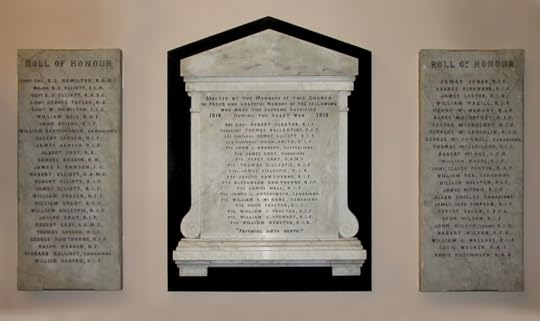
The Memorial Tablets in The Mall Presbyterian Church, Armagh
The book began with the more modest ambition of an article for the Church magazine, profiling the story of one of the soldiers named on the War Memorial. In many projects like this the inspiration often comes from a family story. I had grown up hearing of three great-great uncles who fought in the First World War—William, Joseph and John Johnston of Disraeli Street, on the Crumlin Road. Joseph’s death at Gallipoli in August 1915 was a devastating loss for the family. The next generation of the family were to suffer again during the Belfast Blitz of 1941 when their house in Duncairn Gardens suffered a direct hit and was completely destroyed. Our family left Belfast for Newtownards and the connection with their Belfast community was broken.
William, Joseph and John’s names are carved in stone on the War Memorial in Nelson Memorial Presbyterian Church in North Belfast. However, this Church closed on 25th May 2014. Tragically there is now no congregation to remember them and to acknowledge their sacrifice. This experience inspired me to profile a soldier from The Mall Presbyterian Church in Armagh, where I now worship, and to bring his story to light again.
Thanks to the internet, local experts and living descendants, I began to uncover the largely forgotten lives on some of the sixty-nine names on the War Memorial and Roll of Honour. The magazine article quickly developed into a special church service of remembrance. The “Names Carved in Stone” service was held on 9th November 2014 and the lives of nineteen men and one woman were told and remembered. The result was a poignant and powerfully moving evening. Nonetheless there were forty-nine additional names on the memorial whose lives were equally worthy of being remembered. This book picks up where the service left off.
The goal: To tell the story of the war through the stories of the sixty-nine individuals from The Mall Presbyterian Church who volunteered.
The men featured in Names Carved in Stone were baptised in the Mall church, attended school and Boys’ Brigade together before enlisting for active service. They came from every area of church life—the Minister’s three sons, the Clerk of Session’s three sons, the treasurer’s three sons, the sexton’s son, two members of the church committee and a Boys’ Brigade officer. They featured in all the services and covered many areas of the conflict including the Western Front, Egypt, Salonica, India, the Dardanelles and Mesopotamia. Eighteen men paid the ultimate sacrifice and never returned to their family pews in the Meeting House. Their names are carved in stone on the War Memorial. Fifty men and one woman survived and returned to Armagh, changed forever by their experiences. Their names are carved on the Roll of Honour.
The story of the memorial tablets is also told. The stone mason was a member of the congregation and he carved his own son’s name onto the Roll of Honour.
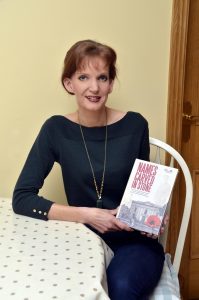
Fiona Berry
The published book is by no means the end of the project. I do not claim to be an expert in the history of the time, and so inaccuracies are inevitable. New information is still being found and there are a couple of stories yet to be told. There are some names on the Roll of Honour that I could not find very much information on, in particular—John Wilson, John Wilson Jnr and Robert Wilson, all of Lonsdale Street. Frustratingly I could find no other trace of them in the Mall Church or in Armagh. I believe that they could be a father and his two sons. Hopefully their story will be unearthed in time. We plan to put all new information found and any corrections in a section on the church website.
I must express my grateful thanks to Rev Peter Gamble, the Elders and Committee of The Mall in their enthusiastic support for this project. I was given free rein to examine all the old books, registers, accounts and minute books which helped me to map out the stories and the connections between them. Using the church records and genealogical sources I could build up a profile of each of the soldiers featured. The result is a moving tribute to the sacrifice made by an entire generation. Many individuals in the congregation and in the community also helped and provided me with lots of significant and useful information.
However, the most important thanks must go to the families whose stories feature in this book. They have all been enthusiastic and helpful. Some I have met, others have been through email, but all have given generously of their time and knowledge. Many have expressed delight that their family story is finally being shared and preserved and it has been a privilege to have been part of that process.
I can remember standing in front of the Memorial Tablets over two years ago not knowing who to pick to feature in a magazine article. None of the names meant anything to me. But I knew that if I had been standing there 100 years before these could have been the names of my brothers or my sons. In learning and bringing to life these men’s lives and their role in the Great War they have become my brothers and my sons.
I hope that as you read their stories and understand their lives that you too will feel a similar attachment and appreciate the sacrifice they made for our freedom.
 Then we can all say with integrity;
Then we can all say with integrity;
“We will remember them.”
Names Carved in Stone is hard backed, 160 pages, full colour, and amply illustrated. It costs £10/12 Euros (including post & packaging within UK and RoI). All profits will be donated to SASRA (Soldiers and Airmen’s Scripture Readers Association). It will be of interest to those who enjoy genealogy, the First World War, congregational life and local history. Books can be ordered from the Mall Church. Contact them via the church website, where you can also download the first update to the book.
Blacker’s Letters – November 1916
The letters written by Lieutenant Colonel Blacker in November 1916 have now been published and they can be read on the project’s website. The letters cover a wealth of subjects from equipment and clothing, to promotion and the award of medals, and, of course, the weather. In a few days Lieutenant Colonel Blacker will go home on leave and we won’t hear from him again until early January 1917/2017.
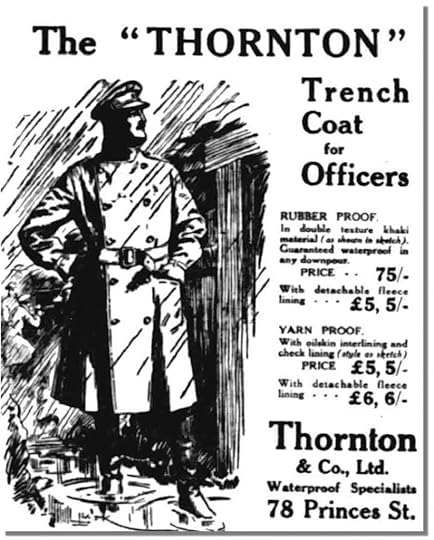
The Thornton Trench Coat – “New Thornton coat and long gum boots kept me quite dry in spite of rain and flood.”
November 10, 2016
Remembrance Day 2016
In memory of:
Naval Airman 1st Class Kenneth Admiral Brown, Royal Navy
Died, 22 April 1940
Acting Sub-Lieutenant (Air Branch) Arthur Stephen Griffith, Royal Navy
Killed in action, 18 January 1941
Leading Airman Alfred Samuel Rush, Royal Naval Volunteer Reserve
Sub-Lieutenant (Air Branch) Philip Donald Julian Sparke DSC**, Royal Navy
Killed in action, 11 May 1941
Twice a year I specifically write a story about Remembrance—for Memorial Day here in the United States and for Remembrance Day in the United Kingdom and elsewhere. A few days ago, I saw seemingly unconnected lines of research come together that led me to a story of wartime gallantry and sacrifice 75 years ago. I was researching a group of Royal Signals soldiers awarded a King’s Commendation for Brave Conduct when I noticed an award to a Maltese Sapper, who had rescued an airman from the sea. Curious (I grew up in Malta), I searched for his story and, in doing so, identified the man that he rescued, his link with three other airmen who died in 1940 and 1941, and discovered a related painting by the renowned Maltese artist Edwin Galea, the father of one of my childhood friends. The story that pulls together these threads is worth telling on this Remembrance Day.
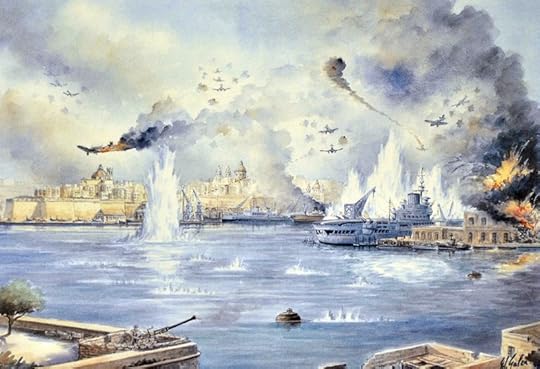
HMS Illustrious at Malta 1941 by Edwin Galea
The tiny island of Malta in the central Mediterranean had a strategic importance out of all proportion to its size during the early years of the Second World War. Bombing of the island began immediately after Mussolini’s declaration of war on 10 June 1940 and, besieged by Axis forces in Sicily, the island suffered a gruelling fight for survival that lasted until November 1942.
In support of the impending German operations in North Africa in early 1941, the Luftwaffe’s Fliegerkorps X had arrived in Sicily in January. One of its first attacks was against the aircraft carrier HMS Illustrious, which was providing air cover for Operation EXCESS, a series of convoys destined for Malta, Alexandria and Greece. Illustrious was badly damaged by the attacks but she made it to Grand Harbour only to be attacked again on 16 January in the first major German air raid against the island—the ‘Illustrious blitz’. You can read more about the attacks and the damage suffered by HMS Illustrious here. The civilian casualties on 16 January numbered 56 men, women and children killed—the majority in Senglea and Vittoriosa.
One of the embarked air squadrons in Illustrious was 806 Naval Air Squadron, the first squadron to be equipped with the Fairey Fulmar Mk 1. Although lacking the performance of the German and Italian fighters, the two-seat Fulmar was a robust and well-armed aircraft and, while HMS Illustrious was in Grand Harbour, the Fulmars of 806 Squadron were based ashore at RAF Hal Far from where they operated against the continued attacks on the island.

Fairey Fulmars at Sea
At 2.15pm on 18 January 1941, an enemy air raid was identified approaching the island. Three Fulmars and five Hawker Hurricanes were scrambled to meet the attack. Unlike the attacks on the previous few days that targeted HMS Illustrious and the ‘Three Cities’, the 80 enemy bombers descended on the airfield at Hal Far, where one hangar was destroyed and two others damaged. A second raid less than an hour later attacked the airfield at Luqa, causing similar damage and destroying several aircraft on the ground. Finally, 30 minutes later, Hal Far was attacked again destroying another three aircraft.
During the fighting over the islands, two Fulmars of 806 Squadron were lost. The first was shot down over Grand Harbour. Unfortunately, the pilot, Acting Sub-Lieutenant A S Griffith, perished; the fate of his observer is unknown. Griffith had been mentioned in despatches for his conduct earlier in the war during the Norway campaign. In the early stages of that campaign he had crashed on landing on HMS Glorious. Although Griffith had escaped from the aircraft after it had gone over the side, his air gunner Naval Airman 1st Class N A Brown was trapped in the wreckage; his body was never recovered.
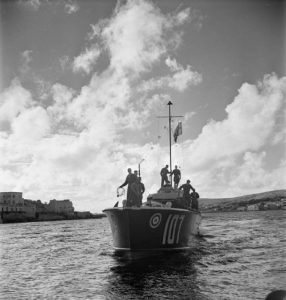
RAF Air-Sea Rescue High Speed Launch 107 (HSL 107)
The second Fulmar was piloted by Lieutenant R S Henley. During the battle, he had shot down a Ju 88 and claimed a Ju 87 ‘probable’.[1] His aircraft was hit, however, and he ditched in the sea off Marsaxlokk on the south-east coast of the island. A Maltese soldier of the Royal Engineers, Sapper Spiru Zammit, was on duty and saw the crash. Without hesitation, he swam out to the ditched aircraft and rescued its observer, Leading Airman Rush, whom he kept afloat until rescued by the fast air-sea rescue launch HSL 107 based at nearby RAF Kalafrana.[2] Lieutenant Henley managed to swim free of the aircraft and he too was picked up by the launch.
Unfortunately, Leading Airman Rush did not survive to the summer. On 11 May, he was the observer in a Fulmar of 806 Naval Air Squadron—now flying off HMS Formidable—providing air cover for Operation TIGER, a resupply run of merchant ships from Gibraltar to Alexandria. Following an engagement with a Ju88, both aircraft crashed into the sea. Both he and the pilot, Sub-Lieutenant P D J Sparke DSC, were killed. Sparke was a most gallant pilot who had been awarded the Distinguished Service Cross in July 1940 for his conduct during the Battle of France and the Dunkirk evacuation. He would receive two more awards of the DSC; later in May a first Bar was announced for his part in the attack on the Italian Fleet at Taranto, and in December a second Bar would reward his conduct in the Mediterranean prior to his death. Leading Airman Rush was mentioned in despatches for his part in the Mediterranean operations.

British Empire Medal (Military Division)
For his gallantry in rescuing Leading Airman Rush, Sapper Zammit was later awarded a King’s Commendation for Brave Conduct.[3] He had been recommended by the Governor and Commander-in-Chief, Lieutenant General Dobbie,[4] for the Medal of the Order of the British Empire but the recommendation had been downgraded by the Honours and Awards Committee to a King’s Commendation; the award was published in the London Gazette on 15 April.[5] Mistakenly, Zammit was told that he had been awarded the British Empire Medal. He dutifully wore the ribbon of his medal throughout the war. The error came to light in 1949 when it transpired that the cable sent to Malta stating that the ‘commendation’ had been approved had been interpreted as the ‘recommendation’ had been approved. Sir Alan Lascelles, private secretary to King George VI, wrote: ‘…I consider, that after a lapse of eight years, it would be manifestly unfair to deprive this man of this award.’[6] When the mistake was explained to the King he immediately approved the award of the medal to Zammit. The announcement, in substitution for the award of the King’s Commendation, was published in the London Gazette on 12 July 1949.[7] The citation stated:
‘A Fulmar aircraft came down in the sea off Marsa Scirocco at about 15.30 hours on the 18th January 1941, about 40 yards from the shore in rough weather. Sapper Zammit immediately dived into the water and reaching one of the pilots held him up until rescued by a speed boat. There can be no doubt that he was largely instrumental in saving the pilot’s life, who was in an extremely exhausted condition.’[8]
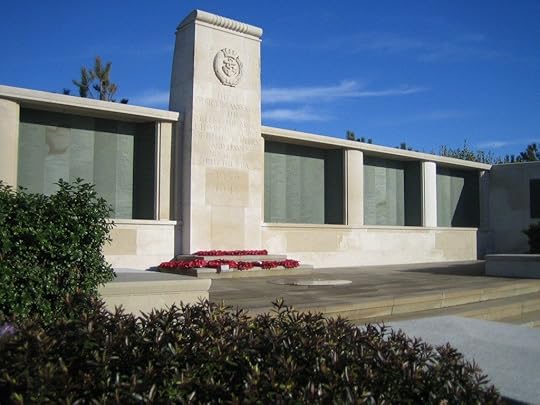
Fleet Air Arm Memorial, Lee-on-Solent
Naval Airman 1st Class Kenneth Admiral Brown, Royal Navy
Kenneth Admiral Brown was born in Rotherham, Yorkshire on 1 December 1914, the son of Harold John Redfern Brown and his wife Meeda (née Summerscales). He died in an aircraft accident at sea when a Blackburn B-24 Skua of 803 Naval Air Squadron, piloted by Midshipman (Air Branch) A S Griffith, crashed while landing on HMS Glorious on 22 April 1940 (see below). He is commemorated on the Fleet Air Arm Memorial, Lee-on-Solent, on Bay 1, Panel 4, and on the war memorial in Conisbrough, South Yorkshire
Acting Sub-Lieutenant (Air Branch) Arthur Stephen Griffith, Royal Navy
Arthur Stephen Griffith was born in the second quarter of 1920, the son of William Arthur Griffith, a shipwright, and his wife Florence Susan (née Cooks), of Iver Heath, Buckinghamshire. He was commissioned into the Royal Navy on 16 January 1939 and qualified as aircrew on No. 4 Air Course at No. 20 Elementary and Reserve Flying Training School, Gravesend, which began on 1 May 1939.[9] On 22 April 1940, 12 Blackburn B-24 Skuas of 803 Naval Air Squadron departed RNAS Hatston in the Orkney Islands to join HMS Glorious for the Norway campaign. As he landed, Griffith crashed and the aircraft went over the side. He was rescued but Telegraphist Air Gunner, Naval Airman 1st Class K A Brown did not escape the aircraft.[10] On 27 April the surviving four Skuas of 803 Squadron joined HMS Ark Royal. Griffith was promoted to Acting Sub-Lieutenant (Air Branch) on 2 June 1940. For his gallantry in April and May 1940 he was mentioned in despatches on 25 June 1940 for ‘daring and resource in the conduct of hazardous and successful operations by the Fleet Air Arm on the Coast of Norway.’[11] Having converted to the Fairey Fulmar, he flew one of three Fulmars off HMS Ark Royal on 9 November 1940 to join 806 Naval Air Squadron in HMS Illustrious. Flying Fulmar L1881 from Hal Far in Malta, Acting Sub-Lieutenant Griffith was killed in action on 18 January 1941, aged 20; he is commemorated on the Fleet Air Arm Memorial, Lee-on-Solent, on Bay 1, Panel 7. His wartime tally was two aircraft destroyed—a Ju88 (Norway) and a Ju87 (Malta)—and three damaged (all in Norway).[12]
Leading Airman Alfred Samuel Rush, Royal Naval Volunteer Reserve
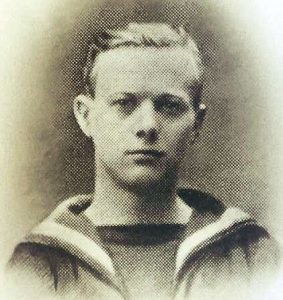
Leading Airman Alfred Samuel Rush
Alfred Samuel Rush was born on 31 January 1915, the son of John Thomas Rush and his wife Alice Mary (née Coward). Rush, known as ‘Dumpy’ by his family, joined the Royal Naval Volunteer Reserve and, mobilised on the outbreak of war, by 1941 he was a Leading Airman serving with 806 Naval Air Squadron in HMS Illustrious. He was shot down on 18 January 1941 over Malta but was rescued from the sea by Sapper Spiru Zammit and the crew of High Speed Launch 107. He subsequently joined HMS Formidable and, while flying as the observer for Sub-Lieutenant Sparke, he was killed in action on 11 May 1941 (see below). He is commemorated on the Fleet Air Arm Memorial at Lee-on-Solent, on Bay 2, Panel 7. He was mentioned in despatches on 1 July 1941.[13]
Sub-Lieutenant (Air Branch) Philip Donald Julian Sparke DSC**, Royal Navy
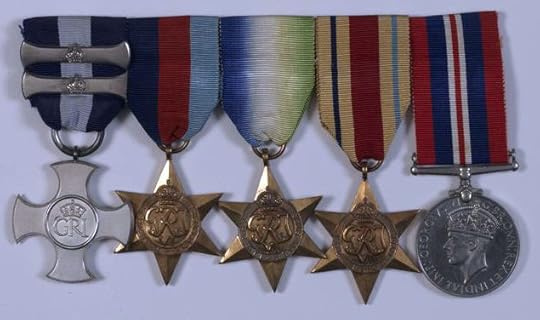
The Distinguished Service Cross and two Bars of Sub-Lieutenant (Air Branch) P D J Sparke DSC, Royal Navy
Philip Donald Julian Sparke was born in 1918, the son of James Donald Sparke and his wife Mary Virginia (née Jefferson). His father served as an airman with the Royal Naval Air Service and the Royal Air Force during the First World War. Sparke was commissioned into the Royal Navy on 4 July 1938 and qualified as a pilot (Midshipman (Air Branch)) at No. 1 Flying Training School, Netheravon, on 10 September 1938. He was promoted to Acting Sub-Lieutenant on 29 November 1939 and to Sub-Lieutenant on 14 March 1940. In the early stages of the war, ‘Spike’ Sparke served with 815 Naval Air Squadron and was engaged in operations in the channel during the Battle of France and the Dunkirk operation, for which he earned his first Distinguished Service Cross ‘…for daring, endurance and resource in the conduct of hazardous and successful operations by the Fleet Air Arm working with the Coastal Command in France and over the Channel.’[14] On the night of 11–12 November 1940, with his observer Sub-Lieutenant J W Neale in Fairey Swordfish L4C (nicknamed ‘Cleo’), he took part in Operation JUDGEMENT, the attack launched from HMS Illustrious against the Italian fleet at anchor in Taranto harbor, for which he was awarded a Bar to his DSC ‘…for outstanding courage and skill in a brilliant and wholly successful night attack by the Fleet Air Arm on the Italian Fleet at Taranto.’[15] In the spring of 1941, he joined 806 Naval Air Squadron, flying Fairey Fulmars off HMS Formidable. While flying with Leading Airman Rush (see above) during operations on 11 May to provide air cover for Operation TIGER, a resupply run from Gibraltar to Alexandria, their Fulmar crashed into the sea after an engagement at very close range with a Ju88 of Staffel 7, Lehrgeschwader 1, which also crashed. He was subsequently awarded a second Bar to his DSC for ‘…courage, resolution and devotion to duty in operations in the Mediterranean.’[16] Sparke is commemorated on the Fleet Air Arm Memorial at Lee-on-Solent. In his brief but spectacular career, his wartime tally was four aircraft destroyed—two Ju52 (off Tripoli) and two Ju88 (off Alexandria)—and two shared—two Ju88 (near Sicily and Malta).[17]
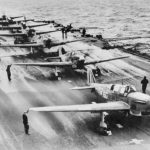
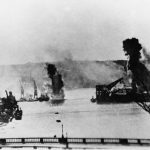

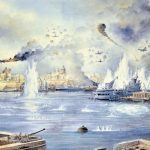
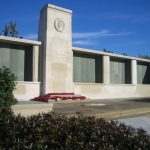

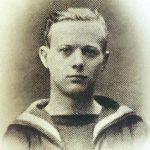
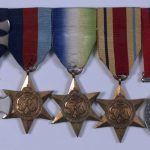
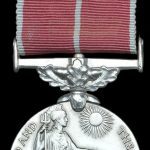
Acknowledgements:
The Australian War Memorial for the photographs of the attack on Grand Harbour, Malta and of HMS Victorious.
Edwin Galea for his permission to use the copy of his painting ‘HMS Illustrious at Malta 1941‘.
The Imperial War Museum for the photograph of the medals of P D J Sparke and High Speed Launch 107.
Juliet Monckton for permission to use the photographs of he great-uncle, Leading Airman A S Rush.
Sources (not mentioned in the footnotes):
Armoured Aircraft Carriers In World War II.
Malta: War Diary. Story of a George Cross.
Attard, J. (1988). The Battle of Malta: An Epic True Story of Suffering and Bravery. Malta: Progress Press.
Cauana, R J. (1997). Malta George Cross: Victory in the Air. Malta: Modelaid International Publications.
1. (Back) Some reports record this action as occurring on 19 January.
2. (Back) Until October 1941, HSL 107 was the only rescue launch based in Malta. By late 1944 she and her crew had rescued 67 allied and 16 enemy aircrew. For an account of the work of HSL 107 see: Jackson, B. (2010). Air Sea Rescue During the Siege of Malta. Leicester: Troubador.
3. (Back) Formal commendations to reward gallantry at a level beneath that of the Order of the British Empire began to be awarded in 1939. These were initially awarded for ‘good services’ to men of the Merchant Navy. They were awarded to civilians from October 1940—the first awards were for ‘gallantry or good service in connection with Civil Defence’—and were termed commendations for ‘brave conduct’ for the first time in December 1940. The first awards to members of the Armed Forces were made to the Army and Home Guard and to the Royal Navy in March 1941 and to the Royal Air Force in July 1941. (Metcalfe, N P. (2014). For Exemplary Bravery. p 7.)
4. (Back) Acting Lieutenant General William George Shedden Dobbie CB, CMG, DSO. Later Lieutenant General Sir William Dobbie GCMG, KCB, DSO.
5. (Back) London Gazette 15 April 1941. Issue 35135, page 2163.
6. (Back) The National Archives (TNA). Public Record Office (PRO). (1939-1945). Recommendation for Award for Zammit, Spiru. WO 373/105/592.
7. (Back) London Gazette 12 July 1949. Issue 38664, page 3407.
8. (Back) TNA. PRO. Op. Cit.
9. (Back) 1938 DH 82a Tiger Moth N-5490. The Pilots.
10. (Back) For an account of the actions of 803 Naval Air Squadron and more about Griffith’s contribution to the operations in Norway see: Smith, P C. (2006). SKUA!: The Royal Navy’s Dive-Bomber. Philadelphia: Casemate.
11. (Back) London Gazette 25 June 1940. Issue 34882, page 3919.
12. (Back) Shores, C. (2004). Those Other Eagles. p 235. London: Grub Street.
13. (Back) London Gazette 1 July 1941. Issue 35204, page 3745.
14. (Back) London Gazette 5 July 1940. Issue 34890, page 4152.
15. (Back) London Gazette 20 May 1941. Issue 35166, page 2869. This was a consolidation list that combined new awards with those that had been announced on two previous lists.
16. (Back) London Gazette 2 December 1941. Issue 35365, page 6890.
17. (Back) Shores, C. & Williams, C. (2008). Aces High. p 560. London: Grub Street.
October 31, 2016
Blacker’s Letters – October 1916
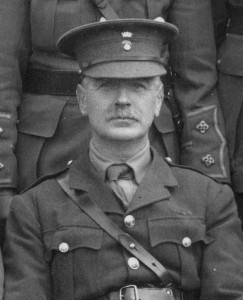
Lieutenant Colonel S W W Blacker DSO
Lieutenant Colonel Blacker’s letters home in October 1916 are all now published and you can read them all on the project’s website. His comments about the weather are reminiscent of those written the year before; this time, however, the Battalion must contend with the nearby River Douve, which regularly breaks its banks flooding the trenches. These letters reflect the routine of life for many in the line south west of Ypres—cold and boring in the most part with occasional flurries of activity and noise, described by Blacker as ‘hideous’.
October 4, 2016
Royal Corps of Signals – Awards for Gallantry and Meritorious Service on Operations 1920-2020
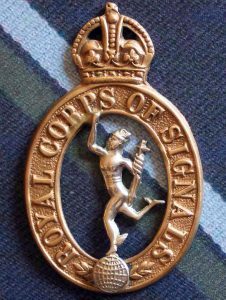 The Corps of Signals was established by Royal Warrant on 28 June 1920.
The Corps of Signals was established by Royal Warrant on 28 June 1920.
Six weeks later, the title ‘Royal Corps of Signals’ was conferred by King George V.
From its earliest days soldiers of the Royal Corps of Signals were engaged in operations across the Empire, most notably in Mesopotamia and on the North West Frontier, and they were duly recognised for their gallantry and valuable service. The majority of awards were made during the course of the Second World War but since then the officers and soldiers of the Corps have been decorated for their gallantry in most of the conflicts in which the British Army has been engaged.
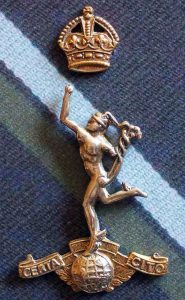
In contribution to the centennial of the Corps, this new book will lay out all of the operational awards made to its personnel, with detailed descriptions of many of the events in which the Corps participated, and previously undiscovered awards and citations. It will be published in 2020.
If you have any information that you would like to share, please get in touch using the contact form at the bottom of the page.

The Distinguished Conduct Medal awarded to Sergeant J R Romaines for his gallantry in close contact with the enemy in North Africa in 1942.
[contact-form]
Acknowledgments:
Chris Walker at Signals Badges for the photographs of the two cap badges.
Phil McDermott for the photograph of the medals of Sergeant J R Romaines DCM.



